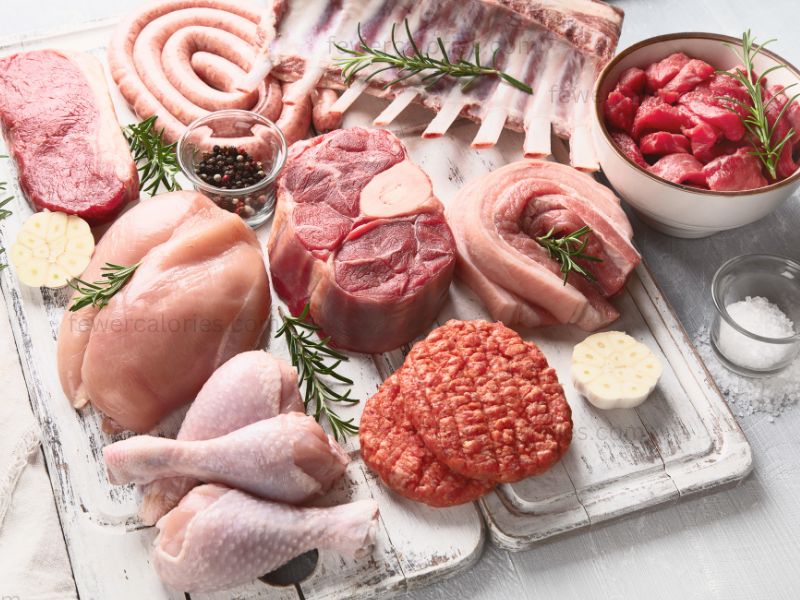The calorie content of meat varies based on the kind and cut of meat. But, in general, lean meats have fewer calories than fatty meats. Here are some of the best options:
- Chicken breast: A 3-ounce portion of skinless, boneless chicken breast contains just around 140 calories, making it a fantastic low-calorie alternative.
- Turkey breast: Turkey breast, like chicken breast, is a lean protein alternative that is low in calories, with a 3-ounce portion having roughly 120 calories.
- Bison meat: is a lean protein source that is lower in calories than beef. A 3-ounce serving of bison has around 143 calories.
- Venison: sometimes known as deer meat, is another low-calorie lean protein alternative. A 3-ounce portion of venison has around 135 calories.
- Fish: Another low-calorie choice is fish, with many types containing fewer than 100 calories per 3-ounce meal. Tilapia, cod, and flounder are a few examples.
It is crucial to note that the technique of cooking can also alter the calorie content of meat. Grilling, broiling, or baking meat is a better alternative than frying, which can add additional calories from the oil.
At the end of this article, we will go over which is the best meat for both health and weight reduction. Now let’s go over how we will come to this decision.
Here are some facts on the health advantages and potential health hazards of each type of meat:
1. Chicken Breast:
Health Benefits: Chicken breast is a rich source of protein, which is necessary for the body’s tissue construction and repair. It’s also low in saturated fat, making it a healthier choice than a lot of other meats. Chicken breast also includes B vitamins, which are necessary for energy generation, as well as minerals such as selenium, which aids in immunological function.
Possible Health Risks: Chicken may be infected with hazardous germs such as Salmonella or Campylobacter, which can cause foodborne sickness if not properly cooked. Furthermore, some research has connected the use of processed meats such as chicken nuggets or chicken sausages to an increased risk of chronic illnesses such as cancer and heart disease.
2. Turkey Breast:
Health Benefits: Turkey breast has a comparable nutritional profile to chicken breast. It is high in protein and low in saturated fat, making it a healthy choice for people wanting to cut calories. Turkey breast is particularly strong in B vitamins, which are essential for brain function, as well as minerals such as zinc and potassium.
Possible Health Risks: Turkey, like chicken, can be infected with dangerous pathogens such as Salmonella or Campylobacter. Furthermore, several studies have shown that eating processed meats like turkey deli meat may raise your chance of developing some malignancies.
3. Bison:
Health Benefits: Bison meat is a lean protein source that has less saturated fat and more omega-3 fatty acids than beef. Bison meat is also high in iron, which is necessary for healthy blood and immunological function. Furthermore, because bison meat is frequently farmed without the use of antibiotics or hormones, it is a more environmentally responsible option.
Potential Health Risks: While bison is usually considered safe to consume, careful handling and cooking are required to avoid foodborne diseases. Bison meat may also be more costly and scarce than other forms of meat.
4. Venison:
Health Benefits: Like bison, venison is a lean protein source with less fat than beef. Venison is particularly abundant in iron and B vitamins, and it may contain more omega-3 fatty acids than beef.
Potential Health Risks: Consuming venison that has not been properly prepared has the same risk of foodborne disease as other forms of meat. Furthermore, some studies have shown that eating red meat, such as venison, may raise the risk of certain health concerns, such as colon cancer.
5. Fish:
Health Benefits: Fish is high in omega-3 fatty acids essential for heart health and brain function. Certain fish, such as salmon, are also high in vitamin D, which is essential for bone health. Also, fish is lower in calories and saturated fat than beef.
Potential Health Risks: Some varieties of fish, such as tuna and swordfish, may have high amounts of mercury or other pollutants. To minimize potential health hazards, it is critical to pick mercury-free seafood and restrict fish intake. Also, some people may be allergic to specific species of fish.
Here’s a table summarizing what we have gone over:
| Meat | Calories per 3 oz (85g) serving | Health Benefits | Possible Health Risks |
|---|---|---|---|
| Bison | 93 | Lean protein, lower in saturated fat, higher in omega-3s than beef | Risk of foodborne illness from improper handling or cooking |
| Venison | 111 | Lean protein, good source of iron and B vitamins | Risk of foodborne illness from improper handling or cooking; red meat may increase risk of certain health problems |
| Chicken breast | 140 | Good source of protein, low in saturated fat, contains B vitamins | Risk of foodborne illness from bacteria like Salmonella or Campylobacter; processed meats may increase risk of chronic diseases |
| Turkey breast | 140 | Good source of protein, low in saturated fat, high in B vitamins | Risk of foodborne illness from bacteria like Salmonella or Campylobacter; processed meats may increase risk of certain cancers |
| Fish | 150-200 | Good source of lean protein, vitamins, minerals, and omega-3s | Some types may contain high levels of contaminants like mercury; some people may be allergic to certain types of fish |

Fish is the best meat for both health and weight reduction. This is why:
Fish is abundant in omega-3 fatty acids and is a good source of lean protein, vitamins, and minerals. Omega-3 fatty acids are essential for heart health and brain function, and they may possibly have anti-inflammatory qualities. Furthermore, some fish, such as salmon, mackerel, and sardines, are high in vitamin D, which is essential for bone health and immunological function.
Weight Loss: Because fish is low in calories and high in protein, it is an excellent weight-loss food. Protein keeps you feeling full and satisfied, which might help you consume fewer calories overall. Furthermore, fish has fewer calories and saturated fat than many other varieties of meat, which can help with weight reduction.
Additional Considerations: Fish is a flexible and tasty dish that can be prepared in a variety of ways, making it simple to integrate into a balanced diet. It is critical to select fish that are low in mercury and other toxins, as well as to avoid eating fish that are rich in calories and fat, such as fried fish or fish with additional sauces or marinades.
In conclusion, because of its nutritional richness, low-calorie level, high protein content, and omega-3 fatty acid concentration, fish is an excellent choice for both health and weight reduction. To optimize the advantages of fish, pick low-contaminant fish and prepare it in a healthy method, such as grilling, baking, or broiling.
© 2012-2023 by LiVentures. All rights reserved. No part of this document may be reproduced or transmitted in any form or by any means, electronic, mechanical, photocopying, recording, or otherwise, without prior written permission of LiVentures.






